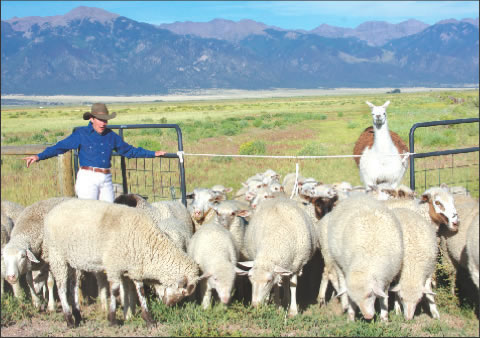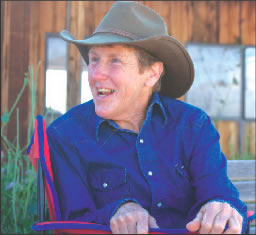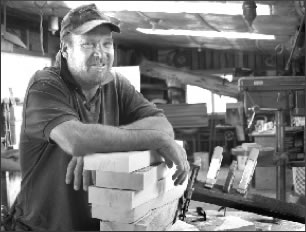by Bill Hatcher
photos by Mike Rosso
It happens without fail every September. Driving down a county road where I live in the northern San Luis Valley, I am given yet another opportunity to ruminate on why I love living here so much. No, not it’s magnificent scenery. Instead, the little reminder of pastoral patience I’m referring to lumbers along over cloven hooves, tended by that durable American icon, the rancher-cowboy, reins or twist-throttle held loosely in gloved hands.
Slowing my truck to a crawl as I pick my way through the dust-coated herd, I’m reminded of ranching’s subordination to the whims of nature, and ranch-life’s matching tenacity. It seems that ever since World War II – and the technologies that sprang from it – ranching has found itself in the tightening arms of a love-hate relationship. It’s a relationship with double-edged technologies and a growing consumer population demanding that ranching do whatever it takes to survive, even if that means “jumping over the moon.”

Never having ranched myself, or paid much attention to it, I had no idea how this lifestyle evolved here in the San Luis Valley, the place I call home. But I decided to talk to a few Valley ranchers at random, ask about their history, how ranching has changed for them (if they still ranch), and their future predictions of ranching in the Valley. Here’s what I discovered.
Jimmy Moore
Jimmy Moore likes his coffee hot and likes it black. He and I met on a sunny July morning at the Villa Grove Trade on Highway 17 in the north end of the Valley. Jimmy sits as tall in his chair at our table as he does behind the wheel of his flatbed dually Dodge pickup truck. Slim, and at around six feet tall under the brim of his navy blue ball cap, you might not guess he was born back in 1926, about one generation after the American frontier was declared closed.
Not long before World War II, Jimmy began working as a ranch hand up near Crestone on the Baca Grant. Even then, money in ranching was tight, so he soon began working in various local mines instead. But after marrying his sweetheart Mary, they inherited 200 acres located five miles north of Villa Grove. Together with another parcel purchased near Moffat in 1957, they invested in 170 head of cattle and began ranching full-time.
In the early days, the Moores stacked hay in enormous mounds to feed livestock, using horses to round up and generally manage their herd. But as time went on, new machinery changed how they ranched. In 1962, they went from haystacks to haybales, In 1966, they dug more wells and installed troughs to help water the herd. They began using a stack-wagon in 1972 to help move the new, heavier bales. But, as Jimmy points out, “Nowadays ranchers sell cattle on the internet and with video sales,” something that no one could have dreamed of only 20 years ago.
By the early 1990s the Moores began retiring from ranching, but two unforeseen events hastened that decision: drought and a broken leg. Jimmy was 76 when he tripped and fell from a hay wagon, snapping his left tibia and fibula.
As for ranching in the Valley today, Jimmy tells me how prices for everything have increased several-fold, while a cow or a sheep still sells for about the same as it did 20 years ago. Add to that the maze of government (BLM and Forest Service) grazing regulations, the cost of fuel and maintaining equipment, plus the fickle weather found at this altitude, and you get a recipe for insolvency.
Unless, of course, you are an agricultural conglomerate. “The little guys get out and the big guys keep going,” is how Jimmy sums up the plight of smaller private ranches throughout the West over the past few decades; when ranching becomes too expensive, ranchers are forced to sell to the highest bidder, usually real estate developers. Developers then set about carving the erstwhile frontier into bite-size, 35-acre “ranchettes.” Meanwhile, larger conglomerates – located mostly in the plains states – are the only ones able to continue operating with shrinking profit margins on economies of scale.
I asked Jimmy if conservation easements might help ranchers hold onto land when they’re in a pinch for money. He agreed that, “easements aren’t such a bad idea – when you can find them.” Such easements are legal agreements made when charitable or conservation organizations pay landowners (usually less than a full-fee price) to permanently (or for a certain period) hold land in a “natural,” undeveloped state. The property still belongs to the landowner, but restrictions are placed both on the current and subsequent landowners.
Jimmy finished off his coffee and looked out the window into a memory. I thought about asking him a question on cultural dietary trends and if that had had any impact on his livelihood, but we’d run out of time and had places to go. Maybe another day.
Peggy Godfrey

Like sunshine on a cool fall day, Peggy Godfrey glows with a passion for ranching that I found at once poetic and practical, crisp yet casual. A baby-boomer from northern Louisiana, Peggy felt an early connection with nature, and later with the clean, hard landscapes of the West. In 1973, Peggy heeded those calls and moved to Taos, New Mexico where she bought her first milk cow. A few years later, Peggy invested in ten heifers, officially starting in the beef business.
In 1988, she moved her growing operation to the San Luis Valley and began ranching “grass-finished” beef. By then the sole proprietor of her own ranching operation, Peggy diversified to include sheep, selling their wool since 1994.
Also helping pay the bills are Peggy’s more creative efforts – her CDs and several published books of poetry and short stories. The inspiration for these works of art came from what she humbly calls “composting her dis-asters.” And even though such creative outlets might be viewed in the laudable tradition of cowboy poetry, it has instead made Peggy the butt of jokes among a few of her local ranching contemporaries.
Nowadays however, Peggy has less to joke about. Until 2002, she was herding up to four dozen cows. As with so many other ranchers in the Valley, the decade-long drought cost her too much money and too many cows, forcing her to sell. But the sheep she began managing back in 1989 proved to be more adaptable and able to suffer through those leaner times and she now owns 67 of them.
Occasional Peggy finds help from her two sons when they come visiting to get a taste of the country. Proud of them and their rural upbringing, Peggy says that “ranching makes people part of an interdependent community and teaches self-sufficiency and responsibility,” virtues all but forgotten in recent times.
Unfortunately, the increasing cost of running a ranch, together with urban sprawl will, in her opinion, make ranching a less viable investment in the future. The Valley water table continues to drop as the Closed Basin Project pumps more water to New Mexico and Texas in order to fulfill requirements of the Rio Grand Compact. Such policies, however, have created a water debt in the northern Valley, making it difficult for ranchers and farmers to enjoy their senior water rights. “Water always flows uphill to money,” is how Peggy describes it, speculating that within ten years ranchers may be charged per acre-foot of water, driving even more ranchers out of business.
While the demands of rapid population growth have whittled away at the amount of land needed for ranching, Peggy believes that many other cuts have come from shifts in cultural values, which increasingly see wildlife as living in serene bucolic harmony with cattle and sheep. And not only this, but also the dizzying array of recreation now common on public lands that includes four-wheelers, dirt-bikes, mountain bikes – even the humble hiker who takes the hound along for fresh air on a Sunday afternoon. Not that there’s anything wrong with any of that, she says. “Public lands belong to everyone. It’s just that most of these people have become so distanced from nature,” that anything truly natural has been reduced to an idealized, abstracted concept in the mind of your average American,” 80 percent of whom are now urbanites in search of the lost primal on our dwindling public lands. Peggy believes that most people will never understand that nature is resilient, yet finite and fragile. Ranchers take pride in caring for it, and in many (though not all) cases improving upon it. Meanwhile, those trying to earn a living in ranching get to bear the brunt of the changing climate in American, and even global, values.
Jim Woodard

If you want to talk to Jim Woodard, a few cold Coors might help grease the wheels, not that Jim’s wheels need any grease at all. But in our conversation, beer was a refreshing rite to be observed as we sat in the shade of his wood shop. Jim also owns and operates a butcher shop nearby – the most popular business in the northern Valley during hunting season. His wife Toni is likewise self-employed with a window-insulation business and house-cleaning operation.
All of which means, of course, that the Woodards no longer ranch. With a note of melancholy in his voice, Jim will tell you that he’s the fifth and final generation in a line of ranchers going back to the 1870s. That’s when the first Woodards put down stakes near Villa Grove. From that time on, his family ranched thousands of cattle and sheep and hundreds of horses on several thousand acres they owned between Saguache and Moffat, plus another huge parcel west of Villa Grove.
Born in the late 1950s, Jim remembers how his family also kept hogs and chickens and farmed oats, wheat and peas. It was a big operation; one that spanned an extensive amount of time and space and involved a considerable amount of sweat to effectively manage.
But even while he was growing up in the 60s and 70s, Jim remembers the ranch starting to decline. He especially recalls episodes of cattle coming down with vibrio (a venereal disease) and other livestock diseases. Added to this was the trend that began with outsourcing the meat industry to places like Argentina and New Zealand, then rising fuel costs. And it seems to Jim that despite, or maybe even because of, so many technologically efficient innovations – bale stackers and nitrogen fertilizers and circle sprinklers – all were overcome by the cost of their maintenance and fuel requirements. The Woodards eventually sold off their machinery and most of their herd to help make ends meet, ultimately culminating in the sale of the ranch itself in 1979.
Jim is adamant that those who continue to ranch must have second and third jobs – though admittedly, this leaves little time for ranching, which was never a nine to five job. Jim predicts that ranching will fade away as mining did, with large ranches being divided into 35-acre developments. Big conglomerates, he says, will never venture into the northern Valley where the weather is too iffy. And as far as cultural trends like vegetarianism and veganism, Jim shruggs, “I have no problem with vegetarians; that’s their choice. It’s no skin off my nose. But I like to eat meat!”
Art and Ileen Rivale
Of the four families I spoke with, only Ileen Rivale and her husband Art are currently in the business of cattle ranching. Over peach cobbler and coffee at Loretta’s Country Kitchen in Villa Grove, Ileen told her story of growing up in southeastern Colorado (Baca County), the daughter of farmer-ranchers. Art’s family also lived in that area and he worked on various ranches. Sooner or later they were bound to meet.
After marrying in the mid-1970s they moved to Westcliffe, where they leased the Clevenger Ranch. In 1984, however, it was sold to developers. Searching for new horizons, they moved their home and herd to an area just east of Villa Grove where they leased 5,000 acres on the old Alexander Ranch (aka Rocking EB Ranch) for summer pasture, as well as securing BLM (Bureau of Land Management) permits. For winter pasture and calving, they purchased about 600 acres of the Company Ranch near Moffat.
Until 2000, Art and Ileen leased around 2,500 yearlings per year in addition to the 100 or so cattle they owned. In those years, they ranched full time, often hiring help. But during the early 90s they began taking seriously the rising cost of health insurance as well as their approaching retirement. Art then began looking for a second job, preferably with retirement benefits. In 1991 he became a state water commissioner, first working in the northern part of the Valley, then transferring to Antonito, where he continues to work today. Ileen found a full-time job in 2006 working for a Saguache County program designed to reduce underage drinking.
Both, however, continued moonlighting as ranchers, and by the late 90s it seemed they’d planned wisely. The same drought that was, by that time, affecting everyone, bit fiercely into their side-lined ranching business – one they still took seriously and with passion. They muddle through, though, thankful for their second jobs, and after Art retires in 2011 he looks forward to getting back to his original dream as a full-time rancher. Ileen also anticipates their shift in livelihood, knowing she may, however, need to continue for awhile in her county position.
I then broached the subject of the future of Valley ranching, asking Ileen’s opinions of conservation easements as a way to save open spaces, if not ranches too. Squinting out the window as she laid her fork down on her plate, Ileen carefully replied, “The way I see it, the idea that land conservation easements are supposed to ‘save’ ranches is a myth, because it’s very hard for the next generation to stay on the ranch and make a living from it. The easements pay for property to protect it from development and can only be sold in the chunk it was signed for.”
This means a person who needs to sell part of their ranch to help make ends meet and continue to ranch is prohibited from doing so under such a legal agreement.
As far as popular trends go, the “red meat scare” that began in the 80s caused the beef industry to take a hit. Only with the “Beef Check-Off” marketing program did trends start to reverse. The program, initiated by the National Cattlemen’s Association, used innovative tactics such as cutting fat from meat during processing, and ran TV commercials encouraging; “Beef – It’s what’s for dinner.”
Ileen echoes the concerns of others, though, when she says that “ranching has also been hurt by development and real estate prices.” As far as cultural perceptions of ranching go, “it’s not hard to see that today’s population is more urban, less connected with land and agriculture. They don’t understand that grazing is part of a healthy ecosystem.” Actually, she says, “It’s the public who uses public lands harder than previous generations.” At the same time, Ileen thinks there will likely “always be ranches, but you’ll just have wealthy people buying them for tax write-offs, or big companies doing it. But you’ll always see those who can make it.”
On a recent warm evening, I eased back on my front porch, popped open a cold beer and corralled my thoughts about all that these folks had said. Ranchers, I found, deal not only with bluebird days, but also rain and sleet and gloom of night – not unlike some fearless postal carriers I know. And most of those who ranch small, private herds have had to hold down second or third jobs just to get by – a lot like a few determined writers I know. But most of all, instead of a static anachronism stuck in time, I discovered that many ranchers must “innovate or evaporate,” just like any other social or business institution. Some have ventured into niche markets such as organic beef, again proving that everything old is new again. Like rodeo cowboys and clowns, ranchers take the bull by the horns and will survive one way or another; a Western allegory that might describe the same crazy ride we all share.
Bill Hatcher is a mostly-vegetarian postal worker, fond of scribbling notes for his first book while driving, yet still able to remain keenly alert for moony livestock.

